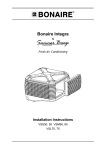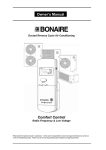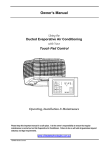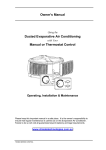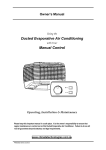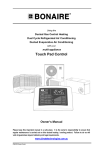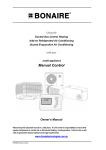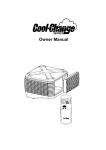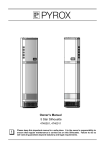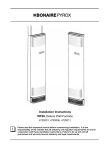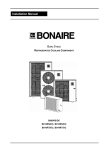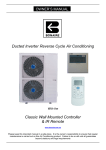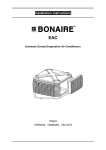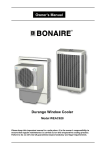Download Celair Profile Series Unit installation
Transcript
` Celair Profile Series Fresh Air Conditioning Installation Instructions Profile 500, 600, 750, 850 Installation Instructions Table of Contents 1. INTRODUCTION____________________________________________________ 3 1.1. Important Notes ____________________________________________________ 3 1.2. Dealer / Installer Responsibility ________________________________________ 3 1.2.1. 1.2.2. 1.2.3. 1.3. Training ____________________________________________________________ 3 Legal & Statutory obligations ____________________________________________ 3 Safety and O.H.&S. Requirements________________________________________ 4 Before Commencing ________________________________________________ 4 2. UNIT LOCATION ___________________________________________________ 5 3. UNIT INSTALLATION ________________________________________________ 6 4. 3.1. Installing the Dropper Duct ___________________________________________ 6 3.2. Installing the Enviroseal Duct Shutter - Optional Accessory __________________ 7 3.3. Installing the Air Conditioner __________________________________________ 8 3.4. Installing the Duct Work _____________________________________________ 10 CONNECTIONS ___________________________________________________ 12 4.1. Water Management ________________________________________________ 12 4.2. Inlet Water _______________________________________________________ 12 4.2.1. 4.2.3. 4.3. Water Drain Connections____________________________________________ 13 4.3.1. 4.3.2. 4.3.3. 4.4. Fitting the Float Valve_________________________________________________ 12 Connecting the Water Supply___________________________________________ 12 Fitting The Overflow Assembly__________________________________________ 13 Fitting the Enviroflow Water Conservation System - Optional Accessory__________ 14 Drainage provisions __________________________________________________ 14 Electrical ________________________________________________________ 18 4.4.1. 4.4.2. 4.4.3. Wiring – Important Notes ______________________________________________ 18 Wiring Connections __________________________________________________ 18 Wiring Diagram______________________________________________________ 19 5. COMMISSIONING _________________________________________________ 20 6. SERVICE (AUSTRALIA ONLY) ________________________________________ 23 Profile Page 2 Installation Instructions 1.0 Introduction 1. INTRODUCTION Please take the time to fully read this Installation manual. Failure to follow these instructions may result in injury to you and damage to the air conditioner or your customer’s property. Installation of this Celair Fresh Air Conditioner must conform to local building rules and regulations, electrical and plumbing codes, Environmental Protection Authority (EPA) regulations, and all applicable Australian Standards. Should you not follow these instructions the unit warranty may be void. The cost of warranty would then be the cost of the customer or the installer / dealer. Refer to the tick box Commissioning Checklist to ensure you have covered all points when the installation is complete. Please complete the Commissioning Checklist tick box in the owner’s manual, as a completed. A signed and dated checklist will be required to verify certain warranty claims. 1.1. Important Notes • TEXT AND ILLUSTRATION COPYRIGHT CLIMATE TECHNOLOGIES 2007 • All rights reserved. No part of this document may be reproduced or transmitted in any form or by any means, electronic or mechanical, including photocopying, recording or by any information storage and retrieval system, without prior permission in writing from Climate Technologies. • Climate Technologies is constantly researching and developing improved product features and therefore reserves the right to change the specifications without notice. E. & O.E. 1.2. Dealer / Installer Responsibility 1.2.1. Training • It is the responsibility of all dealers to ensure their staff are adequately trained to ensure the product is correctly specified. • It is the responsibility of all dealers to ensure their installation teams / subcontractors are trained in the correct installation of product, duct& fittings as well as relevant installation codes and OH&S requirements. • Climate Technologies will provide technical assistance and training to the dealer as required. On going technical support will only be provided to those dealers and installers who attend regular training provided by Climate Technologies. 1.2.2. Legal & Statutory obligations Profile • It is the dealer / installer responsibility to comply to all codes & standards, statutory and legal requirements, state and council / shire by laws. • Relevant certificates of compliance for the installation must be issued. Service may be refused or warranty may be void if the installation is not compliant. Page 3 Installation Instructions 1.0 Introduction 1.2.3. Safety and O.H.&S. Requirements • It is the responsibility of the dealer / installer to insure the environment is safe for the installer to carry out the installation. A risk assessment should be carried out in conformance to state codes of practice. An industry guide to “safe Work at Heights” is available from Climate Technologies. • It is the responsibility of the dealer / installer to ensure safe access to the unit can be achieved for service and that the access conforms to the relevant standards and codes. • It is the responsibility of the dealer / installer to ensure the roof is provided with access footings and platform where the pitch of the roof is unsafe for service access. • It is the responsibility of the dealer / installer to ensure harness anchorage points are provided where units are located on a roof greater than single story or if the pitch and roof construction do not allow safe access. See Australian Standard 1891.4:2000 Part 4 Selection use and maintenance, Table 2.1. 1.3. Before Commencing • Packaging – check there is no damage before removing packaging. Damaged units should not be installed. Climate Technologies should be contacted prior to installation. • Do not install damaged products. Contact your nearest Climate Technologies office for further advice. Installed damaged products will not be covered by warranty. Profile • Have you got all the system components? • Have you got the right unit? • Does the system design conform to the minimum specification of Celres specification and as such fall in line with sound engineering design practices. Page 4 Installation Instructions 2.0 Unit Location 2. UNIT LOCATION 2.1 Unit Location Check List • EPA - A correct installed unit will perform to specification on sound pressure radiated noise. As an installer, you have a professional obligation to ensure that every practical and reasonable effort is made to install this product to best practice guidelines and ensures that any operational noise does not affect neighbours. Complying with EPA / council bylaws for noise abatement is the responsibility of the dealer / installer / owner. • Do not mount the unit on a section of roof that slopes towards a neighbour’s property. • Place the unit well away from sources of smoke, dust and objectionable fumes so that only clean, fresh outside air will be drawn into the unit. Reference should be made to relevant gas codes and state plumbing regulations. • Check the proposed location to ensure that building members are structurally capable of supporting the operating weight of the air conditioner. You may need to consult the roof truss manufacturer. • The unit must be installed in a position that gives safe access for service. It is the responsibility of the dealer / installer to ensure safe access to the unit can be obtained for servicing the product. • Where roof height, pitch or construction will cause OH&S concerns as previously mentioned, service footing supports / platform and or harness anchorage must be provided for safe service. NOTE: The manufacturer and its service providers reserve the right to refuse service unless safety and accessibility to the unit can be guaranteed. • The providing of any extra equipment required to give access to the unit for servicing or warranty repairs is the responsibility of the owner. The unit should face into the customer’s back yard, as low as possible on the roof, with easy, unobstructed access. Keep the unit away from chimneys, flues and vents that will pollute the filter pads and the fresh air being drawn into the house. Profile Page 5 Installation Instructions 3.0 Unit Installation 3. UNIT INSTALLATION 3.1. Installing the Dropper Duct All Celair Fresh Air Conditioners are designed to be fully supported by a metal dropper duct. Metal dropper ducts must be designed, located and fixed to comply to the relevant building codes. Plastic dropper ducts are not recommended for use. Recommended Dropper Sizes Model Dropper Duct Size PROFILE 500, 600, 750 550mm x 550mm PROFILE 850 550mm x 800mm Dropper Duct Height - Roof Roof Pitch Clearance Height 17° 165 mm 22.5° 185mm 25° 195 mm 36° 240mm 3.1.1. Use the recommended dropper duct as advised above. 3.1.2. The dropper must be installed square and level. 3.1.3. It should not touch ceiling joists or other structural members that allow noise and vibration to be transmitted into the building. 3.1.4. Ensure the dropper duct is installed so the unit does not touch the roof. 3.1.5. Fix the duct dropper to the roof structure so that it’s secure and vibration free. 3.1.6. All droppers must be fitted with a splitter pyramid in the base to ensure correct airflow. 3.1.7. All ductwork, electrical cables, water pipes and drains must be fully flashed and sealed to prevent the entry of water into the building. 3.1.8. Plastic dropper ducts should not be used as these may void warranty. Profile Page 6 Installation Instructions 3.0 Unit Installation 3.2. Installing the Enviroseal Duct Shutter - Optional Accessory Step 1 The Enviroseal duct shutter must be installed a minimum of 150mm below the top of the dropper duct. If the dropper duct is fitted with insulation, remove insulation to give the shutter free operation. Step 2 Ensure the Enviroseal is secured horizontally on both angles. Step 3 Ensure electrical cables are not draped across the top of the Enviroseal mechanism Step 4 Ensure the Enviroseal is installed the correct way up. The Enviroseal flaps must open downwards. For more details refer to instructions in the Enviroseal kit. Profile Page 7 Installation Instructions 3.0 Unit Installation 3.3. Installing the Air Conditioner 3.3.1. Remove 4 Louvre panels from unit and place in a safe place to ensure no damage. To remove Louvre: STEP 1. Lift the Louvre assembly up approximately 15mm over the corner post location. STEP 2. Tilt the Louvre back from the top of unit and remove. 3.3.2. The venturi / fan assembly can be removed to assist in carrying the unit on the roof. To remove the fan / venturi assembly:- STEP 1. Disconnect the motor loom from the control box in unit. Caution: Ensure motor wires are reconnected correctly otherwise the product warranty may be void. It is also possible to remove the electrical control box and pump assembly to avoid disconnecting the electrics. STEP 2. Remove fan / venturi assembly by releasing the venturi from the location notches lifting vertically. (There are 4 location notches holding the venturi in place.) STEP 3. Carefully remove fan from the cabinet, not bumping the fan assembly. Profile Page 8 Installation Instructions 3.0 Unit Installation NOTE: Handle the fan/venturi assembly with care, as the fan blade is not protected by the venturi once removed. 3.3.3. Store the fan / venturi assembly in a safe area until final installation to ensure no damage. Store the fan upside down (on the motor) ensuring no damage to the fan assembly. (Do not store in the gutter.) NOTE: Warranty claims for damaged motors, impellers or venturis will not be recognised if the motor / venturi has been damaged during installation. 3.3.4. Lift unit chassis onto the roof. When locating the unit onto the dropper duct, ensure the water reservoir is on the low roof side of the dropper duct. 3.3.5. Fit the unit level on the dropper duct to ensure even water distribution. 3.3.6. Check the unit is located correctly on the dropper duct. Locate the unit on the correct chassis duct location points for the appropriate dropper duct size. The unit should be central on the dropper duct. 3.3.7. Fix the unit into position with self-tapping type screws by screwing through the unit duct adaptor flange and into the dropper duct. A minimum of 4 screws should be used on each accessible side of the unit. Profile Page 9 Installation Instructions 3.0 Unit Installation 3.3.8. Lift the fan deck onto the roof and reinstall into the unit. Ensure the venturi is correctly rotated for the motor wiring loom and has snapped into the location notches. Spin fan blade by hand to ensure that the blade does not touch the inlet ring. 3.3.9. Reconnect the fan loom to the control box. 3.3.10. Connect the 24-volt water solenoid cable to the control (where fitted). 3.3.11. Connect communication cables to the control box 3.3.12. Feed the communication cable and the 240-volt plug and cable set through the 50mm electrical entry drilled into the dropper duct. Ensure the 50mm rubber grommet supplied is used to ensure an electrical hazard is not created. 3.4. Installing the Duct Work 3.4.1. Use only insulated ductwork to a thermal resistance of insulation minimum of R0.6, designed and installed to ‘CELRES’ System Design guidelines. All bends must have a minimum radius of 1.5 times the diameter. All joins must be taped airtight. 3.4.2. Flexible ductwork connected to the dropper duct must be designed and installed to the ‘CELRES’ System Design Guide in conjunction with industry based best guidelines. 3.4.3. Cut flexible duct to the correct length to ensure no excess duct is left in the system. This will insure minimum system resistance and maximum air flow. 3.4.4. All duct work should be streamlined. Avoid sharp angles that will reduce airflow. 3.4.5. The minimum bend radius is 1.5 times the duct diameter 3.4.6. The last bend to each ceiling register must be a smooth radius so that airflow is even into the room. 3.4.7. Do not squash duct work to fit through small openings, as airflow will be restricted. Find a better location. 3.4.8. If more than 6 metres of flexible duct work are required in one length, the next size up flexible duct must be used. 3.4.9. All duct work in ceiling spaces or hot areas must be well insulated. 3.4.10. All external exposed duct work must be weatherproofed. 3.4.11. All duct work must be taped airtight. Profile Page 10 Installation Instructions 3.0 Unit Installation The last bend to each ceiling register must be a smooth radius so that airflow is even into the room Profile Page 11 Installation Instructions 4.0 Connections 4. CONNECTIONS All water connections must be carried out by a licensed plumber. A plumbing certificate of compliance is required. Correct water management in an evaporative air conditioner is vitally important to the operation and longevity of the product. If the water management is not set correctly by the installer to the local water condition, warranty will be void. Maintaining correct water management is the responsibility of the owner of this appliance and warranty will also be void if correct settings are not maintained. 4.1. Water Management • The definition of hard water is 300 ppm or greater. • Water bleed rates or the dump cycle times must be set to a rate appropriate to the local supply water conditions. No scaling should be evident where the dump cycle / bleed rates are set correctly. This will ensure maximum cooling and filter pad life, reduced opportunity for scaling and therefore less regular maintenance. NOTE: Where water quality is of high mineral content e.g. bore water, bleed off will be required in conjunction with a regular timed dumping cycle. 4.2. Inlet Water 4.2.1. Fitting the Float Valve STEP 1. Remove nut from float valve assembly. STEP 2. Ensure rubber washer is fitted inside the tank on the float valve. Fit float valve assembly in tank. STEP 3. Fit the nut to the valve on the underside of the tank. Do not over tighten. NOTE: In areas of low water pressure it may be necessary to remove the water flow restrictor from the inside of the valve. Minimum water pressure required to operating the float valve is 100 kpa. STEP 4. Fit elbow supplied to the float valve. STEP 5. Fit the 24-Volt AC water solenoid valve to the elbow. STEP 6. Fit Flexible Connector to solenoid valve 4.2.3. Connecting the Water Supply Profile • The water supply pipe work and connection to the air conditioner must be installed by a licensed plumber and conform to AS 3500, state & local plumbing regulations. • Ensure water pressure to the appliance does not exceed the maximum static pressure of 500kPa (50 m head) as per AS 3500 (section 3.3) Page 12 Installation Instructions 4.0 Connections • Unit water connection a ½” BSP female flexible connection. Use the flexible connector supplied for the connection between the isolating cock and the solenoid / float valve. NOTE: In areas where water pipes freeze, a low level drain tap or pressure expansion control valve provision will be needed to drain the water piping to prevent damage to the air conditioner. The customer should also be advised on its operation by the dealer / installer. • Ensure the approved water supply pipe is of the correct length and is secured to prevent tension on the solenoid / float valve fittings. • The supply pipe should be 12mm copper pipe or similar approved. A ¼ turn ball isolating valve must be installed on the supply pipe near the unit for ease of maintenance. Do not use duo or non-return valves of any kind including stop taps with jumper washer. NOTE: Non return type valves can have an effect on the operation of the water solenoid valves. Lock up and damage can be caused. Non return valves are not required as the product conforms to MP52 Spec 101:2001 Plumbing safety licence. • Before connecting the supply pipe flush it of any swarf or debris that may cause the float valve or solenoid to leak. NOTE: Failure of the Solenoid valve or Ball Float due to debris or swarf will not be covered by warranty and is therefore the responsibility of the installer / owner. 4.3. Water Drain Connections 4.3.1. Fitting The Overflow Assembly The overflow fitting connection size is 50mm BSP. STEP 1. Remove nut and rubber washer from over flow assembly. STEP 2. Place rubber washer inside the tank and fit overflow assembly. STEP 3. Fit the nut to the overflow fitting on the underside of the tank and tighten ensuring no leaks. Profile Page 13 Installation Instructions 4.0 Connections 4.3.2. Fitting the Enviroflow Water Conservation System - Optional Accessory – (This does not replace the Overflow Fitting) The Enviroflow water conservation system uses water pressure to close the dump valve. There is a requirement for a minimum of 100kpa water pressure to maintain the dump valve mechanism closed. STEP 1 Remove nut from the dump valve. STEP 2 Fit the dump valve into the 40mm hole in the tank and tighten nut from the underside of the tank ensuring no leaks. STEP 3 Fit the 24-volt cable between the solenoid and the control box routing it through the overflow fitting. Connections are not colour specific. STEP 4 Fit pressure hose between the solenoid valve and the top of the dump mechanism routing it through the over flow fitting and trim to length. Fit all wiring pressure hose in a professional manner. 4.3.3. Drainage provisions The discharge pipe must have an internal diameter of no less than the internal diameter of the unit connection provision supplied by the manufacturer. Provided is both a 40mm and a 20mm fitting for the dump valve The following diagrams are typical and provide guidance for evaporative cooler installers on the permitted ways to discharge the drains from evaporative coolers in accordance with the Plumbing Standards Regulations. Note: Discharge water must be managed in accordance with State and Local Government statutory requirements and local by laws. For water conservation purposes, the waste water from the evaporative unit could be stored and used at a later date and used for watering pot plants. Profile Page 14 Installation Instructions 4.0 Connections OPTION 1. A discharge point to a roof gutter pop outlet, providing the downpipe is not used for the collection of water for potable use. OPTION 2. Direct to downpipe via a tundish, providing the downpipe is not used for the collection of water for potable use. OPTION 3. A surface stormwater drainage system. Provided the surface is graded away from the building and ponding does not occur, and the discharge does not present a safety risk to pedestrians (eg. across a footpath). Profile Page 15 Installation Instructions 4.0 Connections OPTION 4. A sanitary drainage system via a tundish in one of the following forms in accordance with AS/NZS 3500.2.2 - 1996 clause 4.6.7.8 & 11.22. ii) To a floor waste gully iii) Direct to sanitary drain Profile Page 16 Installation Instructions 4.0 Connections OPTION 5. An absorption pit. Provided the following conditions can be met: • Only permitted where no sanitary or surface water drainage is available. • The pit can only be constructed in permeable ground • Of a size appropriate for the volume of discharge • Located so the discharge water will not cause damage to buildings by changing moisture conditions. OPTION 6. To a suitable water spreader. Profile • Tiled roofs only • Spreader design should be such that water will not spill over the gutter • Providing the roof is not used for the collection of water for potable use. • Spreaders should not be used on tiles that are porous. Page 17 Installation Instructions 4.0 Connections 4.4. Electrical 4.4.1. Wiring – Important Notes • A LICENSED ELECTRICIAN must carry out 240-volt connection wiring to the unit. It is the responsibility of the LICENSED ELECTRICIAN that the unit is connected as per AS3000 (Wiring rules) and any local regulations and statutory or legal requirements. A compliance certificate is required for any new electrical connections. • It is the recommendation of Climate Technologies that a dedicated circuit be fitted from the distribution board with a separate circuit breaker. This may be an electrical authority requirement in some states, and is precautionary in other states for future additions where an existing circuit is used. • Do not use an extension cord to reach the GPO. This is illegal and unsafe. An Electrician must relocate the GPO if the plug and cable does not reach. 4.4.2. Wiring Connections • Profile Have a licensed Electrician install a dedicated circuit from the distribution board with a separate circuit breaker and a 10 Amp GPO (generalpurpose outlet) within 600mm of the dropper duct. Page 18 Installation Instructions 4.0 Connections • Drill a 50mm (2”) hole in the dropper to bring the service lead and controller cable into the ceiling space. The rubber grommet fitted to the service lead is used to seal the hole in the dropper from the inside. • Connect the controller and solenoid cables into the control box. Refer to Controller installation and commissioning instructions • • Plug the pre-wired service lead into the GPO. Electrical leads must not be draped over the fan deck or loosely around the unit and must be fastened securely. 4.4.3. Wiring Diagram Profile Page 19 Installation Instructions 5.0 Commissioning 5. COMMISSIONING 5.1. Water Levels 5.1.1. Turn water on to unit and allow unit to fill. The water should be 30 to 35mm from the top of the overflow. 5.1.2. If an Enviroflow Water Conservation System is fitted, turn the unit on and set the pre-cool function. This will activate the solenoid valve and allow time to check the float valve setting. 5.1.3. Adjusting the float valve arm: while the float valve arm is factory set some adjustment may be required. Adjust with care. 5.1.4. Fit Louvre panels and check for even wetting of the filter medium. 5.2. Dialflo Settings 5.2.1. Filter Rate – Outer Knob • Ensure the filter knob is opened to get water flow to the distributor. Turn Filter anti clockwise to increase water flow. • If water lift off is noticed, the flow rate can be adjusted. Turn anti clockwise to reduce the flow to the distributor. 5.2.2. Bleed-off Rate – Inner Knob Profile • Always set the bleed rate after the flow rate has been determined. • To set the bleed rate, hold the filter flow knob at its current setting while adjusting the bleed rate. • All evaporative air conditioners need some water bleed-off to prevent build-up of mineral deposits in the system. The correct setting of the bleed rate will ultimately govern the life of the unit. Page 20 Installation Instructions 5.0 Commissioning • With normal town water supply, bleed rate should be adjusted so that the discharge is not less than 10 litres per hour. Increased water hardness may require a higher bleed rate and increased maintenance. • It is recommended to plumb the bleed off hose through the overflow fitting and to waste as the discharge may cause unsightly stains. NOTE: It is the responsibility of the installer / owner to set a correct bleed rate to suit local water conditions and ensure that rate is maintained. 5.3. Dump Valve Settings Correct water management in an evaporative air conditioner is vitally important to the operation and longevity of the product. If the water management is not set correctly by the installer to the local water condition, warranty will be void. Maintaining correct water management is the responsibility of the owner of this appliance and warranty will also be void if correct settings are not maintained. • Where a dump valve is fitted and is set up for regular timed dumping periods during operation, the bleed may not need to be set. Check the level of dissolved solids in the water supply to make this determination. Dump valves are required where water hardness is greater than 300ppm. • Dump times available on RF / LV Programmable and the Touchpad controls. Dump cycle times available are 0, 1, 2, 4, 8, 12 and 24 hour. • Where a dump valve is only used for the purpose of a dry sump when not in use, the bleed rate will have to be set for the conditions of operation. NOTE: It is the responsibility of the installer to set the correct dumping period to suit local water conditions. 5.4. Fan Operation • Set the fan running and check the fan is clear of the venturi. • Check that the air is being evenly distributed through the ductwork. • Make adjustments, as required, to any manual air dampers that may be fitted. 5.5. Controls • Refer to your control installation and commissioning instructions. 5.6. Customer hand Over 5.6.1. Instruct the customer in the use of the product. • Controls • Bleed off • Venting the air via the side of the home the wind is not blowing from. • Maintenance Requirements 5.6.2. Hand over of the customer’s operational manual. Profile Page 21 Installation Instructions 5.0 Commissioning 5.7. Commissioning Check List You must complete, date and sign the ‘tick box’ checklist in the owner’s manual. Use this copy to check the installation prior to completing the owner’s documentation. Unit All equipment ordered by the customer is installed. The unit is level and secure. The tank is free of foreign matter and debris and the water isolating tap is turned ON. Water drainpipe work is completed and sealed. The water basin fills with water and the float valve closes correctly when the water level is 30-35mm below the overflow level. The water pump operates correctly when turned ON at the controller. The dump valve cycle times and / or Dialflo water bleed rate are set to suit local water conditions. The Enviroflow Water Conservation System. The tank drains correctly when unit turns off. The fan deck is correctly located and the fan blade spins freely. The mains and control wiring are complete and the circuit breaker and GPO are turned ON. The fan operates through the entire speed range. The minimum fan speed is correctly set. Profile The water supply line has been flushed to clear swarf and debris and is free of leaks. Water distribution is even with the filter pads fitted and the air conditioner operating pump and fan. All Controller functions for the appliance operate. Page 22 Installation Instructions 5.0 Commissioning Ductwork and general The Enviroseal functions correctly with the shutters opening downwards at 90° All roof penetrations are fully sealed and watertight. All ductwork is completed to plan, correctly supported and airtight, with no bend less than 1.5 x the ductwork diameter. Air distribution checked, dampers are adjusted and all outlets correctly adjusted and wiped clean. Man hole cover replaced. All rubbish has been removed from inside and on the roof. Site Customer Hand Over You have explained the following to the customer. The operation of the Controller. 6. The need to open windows and doors for the correct operation of Fresh Air Conditioning The operation of the bleed or dumping system and it’s importance to operate all the time Stick the Serial Number Label of the unit in the owners manual Maintenance requirements SERVICE (AUSTRALIA ONLY) 6.0 Service A qualified service technician should conduct any service work carried out on this ducted cooling product. It is important that periodical service is carried out on the product to ensure the customer receives the efficiency benefits the product provides. Only an authorised Climate Technologies service provider can carry out warranty service. Profile Page 23 Manufactured by Climate Technologies ABN 13 001 418 042 26 Nylex Avenue Salisbury, SA 5108 Australia www.climatetechnologies.com.au 6052271/A
























